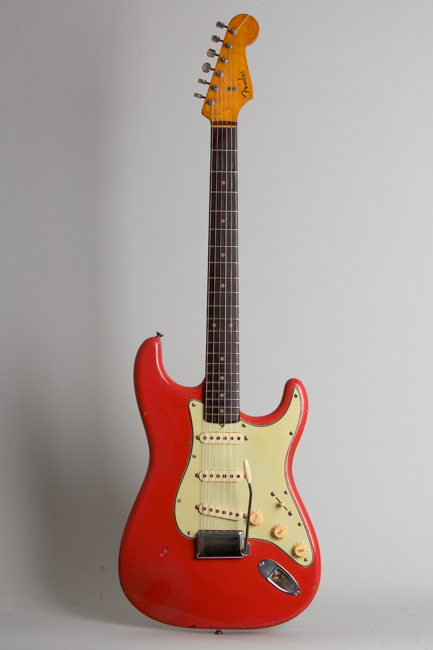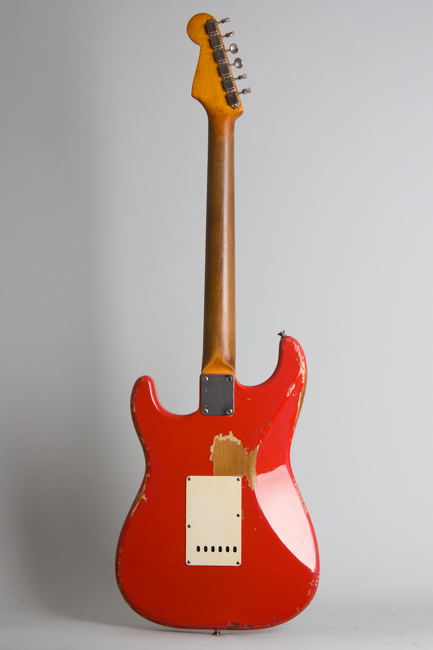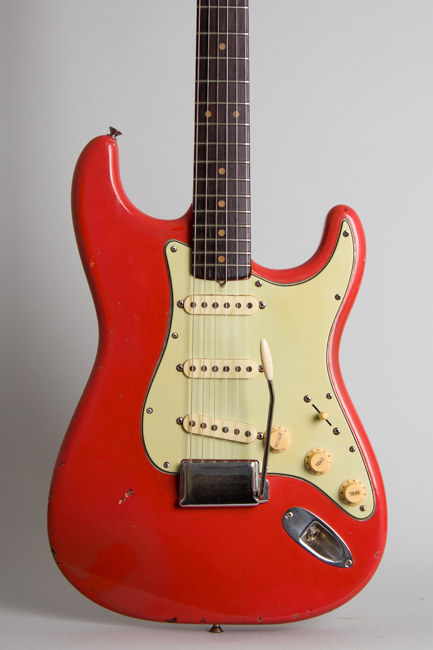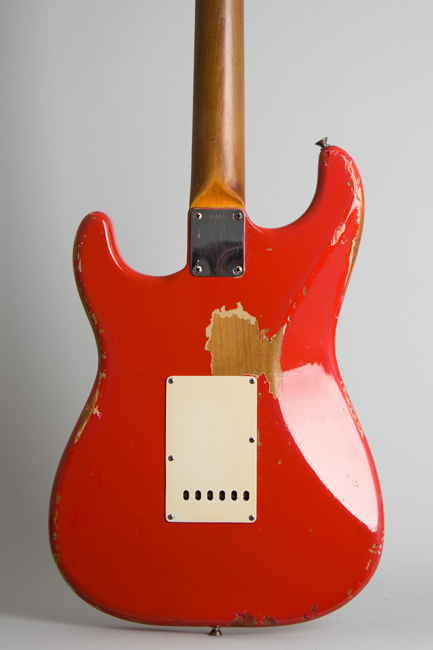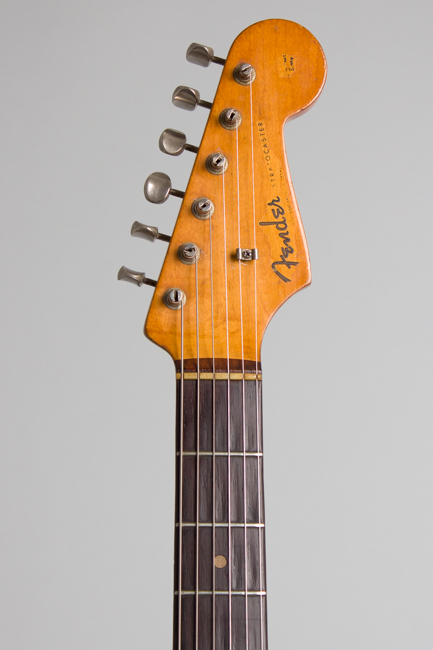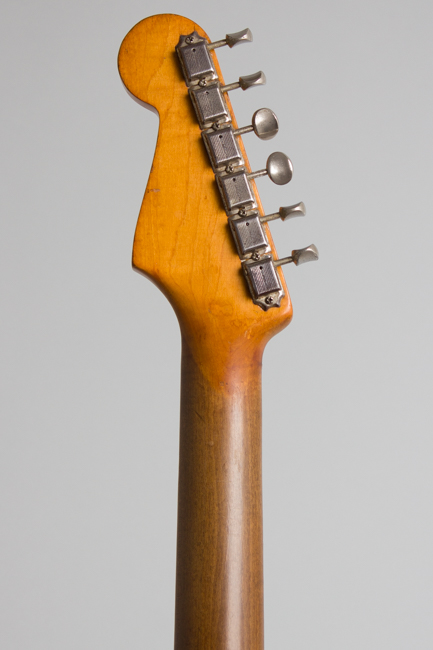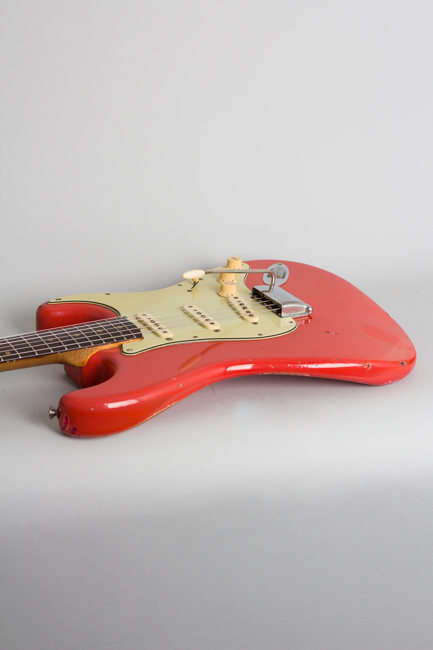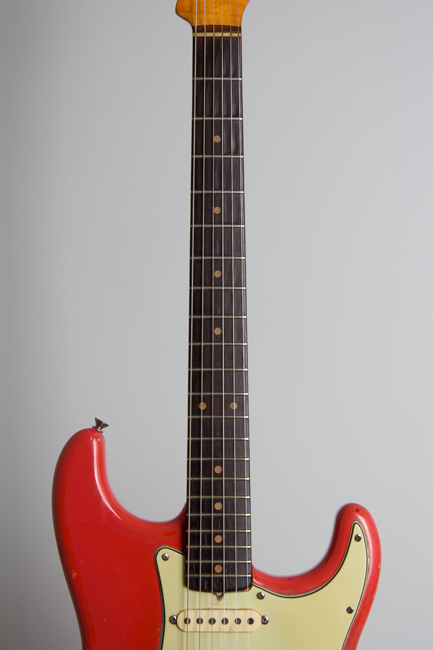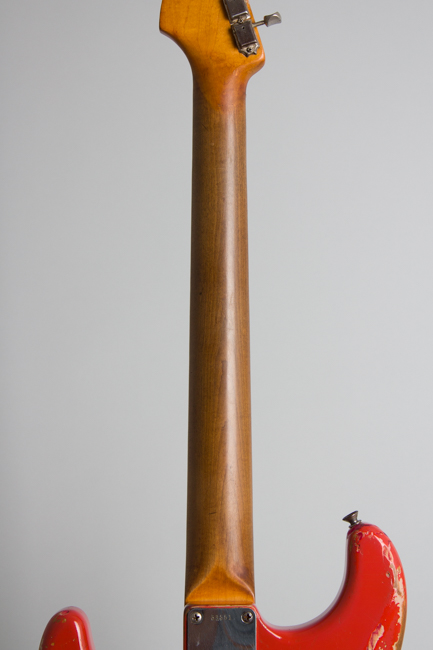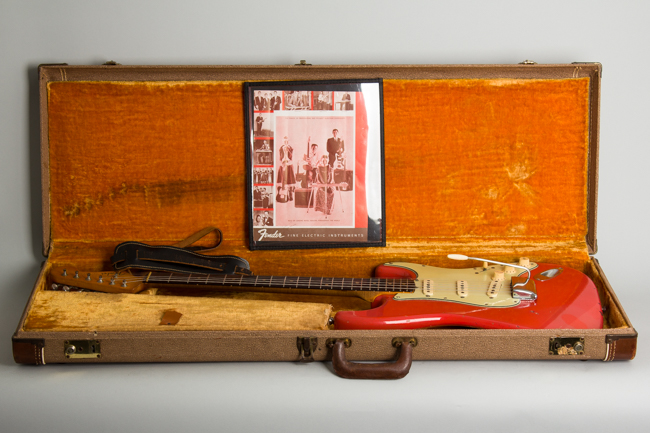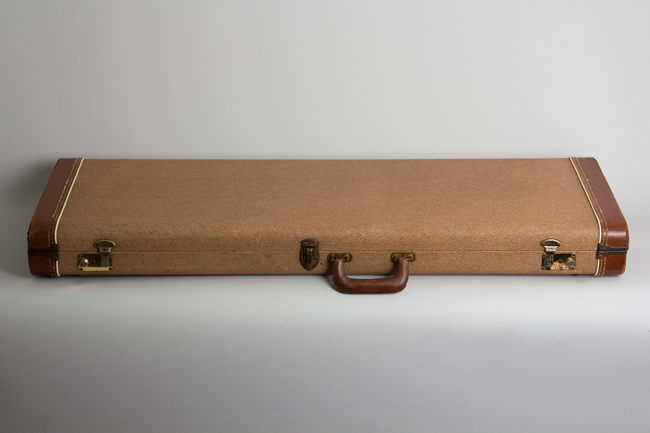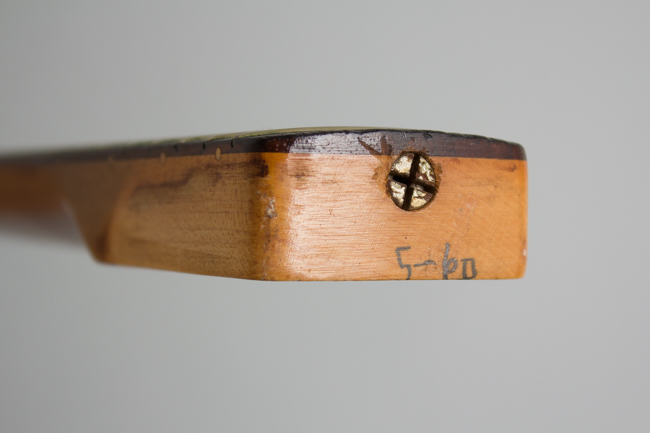Fender Stratocaster Solid Body Electric Guitar (1960)
End of Summer Sale - PRICE REDUCED!
This item has been sold.
Item # 10826
Prices subject to change without notice.
Fender Stratocaster Model Solid Body Electric Guitar (1960), made in Fullerton, California, serial # 53551, Fiesta Red finish, alder body, maple neck with rosewood fingerboard, original brown tolex hard shell case.
Fender Stratocasters don't get a whole lot more iconic than this one! It is a truly beautifully worn in but superbly original early slab-board Pre-CBS Stratocaster in Fiesta Red, one of Fender's most desired Custom Colors. It has been rather heavily played over the last six decades but nicely cared for with a beautiful patina and vibe to spare.
This Stratocaster dates to mid-1960, just at the dawn of the surf/instrumental rock era. Custom color Stratocasters were always sold in far smaller numbers than sunburst, but the proportion was much higher in the mid 1960s. When this guitar was built the official Fender Custom Color chart was still a year away; the option of non-standard "Custom Duco" finishes was noted in small print on the price lists at a 5% upcharge. This guitar would have been individually ordered through a dealer/customer interaction. While this shade would be codified as "Fiesta Red" on the official chart, when this one was finished in 1960 Fender insider Bill Carson called this color "Cimarron Red".
Beyond the body finish this Strat shows typical 1960 features, different in several ways from its recent 1950s ancestors. The neck is dated 5-60 on the heel with the thick rosewood fingerboard used from mid-1959, now referred to as the "slab board" to distinguish it from thinner laminates Fender substituted after mid-1962. It is inlaid with "clay" dots that would be phased out in favor of pearloid at the end of 1964. The pickguard is the three-layer "green" Nitrocellulose that replaced single-layer ABS plastic in 1959. The neck carries the original smaller Pre-CBS style headstock with the older gold "Spaghetti" logo decal that was also replaced in 1964.
The finish on the body has been worn and weathered quite a bit over the decades but retains a strong red hue. The pots carry date codes of the 20th week of 1960. The pickups, wiring and solder joints are original and undisturbed including the masking tape used to secure the leads. All three single coil pickups have a strong well-defined tone, and the "in between" settings offer up the familiar "Stratty" quack without sounding as glassy as many. These early 1960s slab board Stratocasters have become a player's favorite over the last few decades, with a somewhat meatier tone than either the earlier maple fingerboard guitars or the later CBS period examples.
When this guitar was assembled in mid-1960 the Stratocaster was still a popular model in the US but had been supplanted by the Jazzmaster as Fender's top of the line. Many Surf'n'Twang players over the next few years would favor the Jazzmaster and its flashier sister the Jaguar, but the Stratocaster remained distinctive with its 3-pickup layout and unique trem system. Surf Master/Originator Dick Dale always exclusively favored the Stratocaster, proclaiming he could not see why others would use anything else!
The Fiesta Red slab-board Stratocaster has a far deeper cultural significance in England, where it epitomized the rock & roll electric guitar to an entire generation due to the influence of Hank Marvin of the Shadows. Marvin's first Strat was a red maple neck model, but the band soon brandished a set of Fiesta red slab-board Strats (and a matching Precision Bass) that became their signature look and sound. To thousands of aspiring English guitarists the red Fender was the epitome of cool, and both the genuine article and numerous cheaper copies defined UK pop culture in the early '60s.
Today well into the 21st Century this remains a super vibey and great-sounding slab-board Strat, an example of what Fender's reputation was built on well before "things started a-changin" with the January 1965 sell-out to CBS. All early custom color Stratocasters are rare; this may not be the hardest to find hue but it is arguably the most classic of all.
Overall length is 38 15/16 in. (98.9 cm.), 12 3/4 in. (32.4 cm.) wide at lower bout, and 1 1/2 in. (3.8 cm.) in depth, measured at side of rim. Scale length is 25 1/2 in. (648 mm.). Width of nut is 1 5/8 in. (41 mm.).
This fine example of prime Fender mojo has been fairly heavily played over 60+ years but never abused. It remains an all-original guitar, showing a decent amount of wear from use but still in fine playing condition. The somewhat fragile early Custom Color body finish retains very strong color with only some minor fade, with some light clouding to the top coat in spots. The lacquer shows an wide assortment of dings, dents, scrapes and chips with the heaviest along the edges and a decent area of belt buckle wear to the back. There is some typical armwear on the upper body, worn through the upper color coat but not through to the primer below. The instrument still presents better than many from this period, without large swaths of finish worn to the wood.
The body has several small touched-in spots around the upper strap button; it appears a previous owner must have used a strap that wore into the wood and attempted to clean up the area. Similar wear spots are visible around the lower strap button, but most of the touched-in finish has been worn away again. There are a few other small touched-up spots here and there but no wholesale finish alterations or overspray. The beautiful "green guard" has not shrunken up as much as many have; it has no cracks and all the tips are intact but it does have some notching by the neck from truss rod adjustment. The spot on the body below the rod (under the pickguard) has been slightly dressed away to facilitate this.
The neck finish is *heavily* worn down to the wood over its entire length; it has that perfect "Played in Fender" feel that modern relicers attempt to artificially re-create. The fingerboard has some noticeable wear and the original small wire frets have been crowned down a decent amount; they remain functional but players who prefer a larger wire would likely want a refret before too long. The headstock finish has some checking and chipping but it and the original decal remain largely intact; the bottom of the "F" has flaked a bit.
Internally the guitar is unaltered with untouched solder joints and all original components. The black-bobbin pickups sound great in any combination. The bridge base, saddles and screws have some typical corrosion but everything is fully functional; all the height adjustment screws are correct style but some in the center may have been replaced along the way as they are less corroded than the others. The trem arm some plating loss but are still in good shape; the trem is set up with four springs. The original plastic trem plate on the back is well preserved has no missing corners; even the original chrome bridge cover is still along for the ride.
While obviously heavily played this Strat is a better and cleaner survivor than many, and a considerable Fender rarity in this early solid color finish. This is a real stunner to behold, delightful piece of the slab-board Fender era grail. It retains the original brown Tolex hardshell case in relatively clean condition with a period strap and older reprint of the 1959 Fender "Down Beat" catalog in the pocket. Excellent - Condition.
Fender Stratocasters don't get a whole lot more iconic than this one! It is a truly beautifully worn in but superbly original early slab-board Pre-CBS Stratocaster in Fiesta Red, one of Fender's most desired Custom Colors. It has been rather heavily played over the last six decades but nicely cared for with a beautiful patina and vibe to spare.
This Stratocaster dates to mid-1960, just at the dawn of the surf/instrumental rock era. Custom color Stratocasters were always sold in far smaller numbers than sunburst, but the proportion was much higher in the mid 1960s. When this guitar was built the official Fender Custom Color chart was still a year away; the option of non-standard "Custom Duco" finishes was noted in small print on the price lists at a 5% upcharge. This guitar would have been individually ordered through a dealer/customer interaction. While this shade would be codified as "Fiesta Red" on the official chart, when this one was finished in 1960 Fender insider Bill Carson called this color "Cimarron Red".
Beyond the body finish this Strat shows typical 1960 features, different in several ways from its recent 1950s ancestors. The neck is dated 5-60 on the heel with the thick rosewood fingerboard used from mid-1959, now referred to as the "slab board" to distinguish it from thinner laminates Fender substituted after mid-1962. It is inlaid with "clay" dots that would be phased out in favor of pearloid at the end of 1964. The pickguard is the three-layer "green" Nitrocellulose that replaced single-layer ABS plastic in 1959. The neck carries the original smaller Pre-CBS style headstock with the older gold "Spaghetti" logo decal that was also replaced in 1964.
The finish on the body has been worn and weathered quite a bit over the decades but retains a strong red hue. The pots carry date codes of the 20th week of 1960. The pickups, wiring and solder joints are original and undisturbed including the masking tape used to secure the leads. All three single coil pickups have a strong well-defined tone, and the "in between" settings offer up the familiar "Stratty" quack without sounding as glassy as many. These early 1960s slab board Stratocasters have become a player's favorite over the last few decades, with a somewhat meatier tone than either the earlier maple fingerboard guitars or the later CBS period examples.
When this guitar was assembled in mid-1960 the Stratocaster was still a popular model in the US but had been supplanted by the Jazzmaster as Fender's top of the line. Many Surf'n'Twang players over the next few years would favor the Jazzmaster and its flashier sister the Jaguar, but the Stratocaster remained distinctive with its 3-pickup layout and unique trem system. Surf Master/Originator Dick Dale always exclusively favored the Stratocaster, proclaiming he could not see why others would use anything else!
The Fiesta Red slab-board Stratocaster has a far deeper cultural significance in England, where it epitomized the rock & roll electric guitar to an entire generation due to the influence of Hank Marvin of the Shadows. Marvin's first Strat was a red maple neck model, but the band soon brandished a set of Fiesta red slab-board Strats (and a matching Precision Bass) that became their signature look and sound. To thousands of aspiring English guitarists the red Fender was the epitome of cool, and both the genuine article and numerous cheaper copies defined UK pop culture in the early '60s.
Today well into the 21st Century this remains a super vibey and great-sounding slab-board Strat, an example of what Fender's reputation was built on well before "things started a-changin" with the January 1965 sell-out to CBS. All early custom color Stratocasters are rare; this may not be the hardest to find hue but it is arguably the most classic of all.
Overall length is 38 15/16 in. (98.9 cm.), 12 3/4 in. (32.4 cm.) wide at lower bout, and 1 1/2 in. (3.8 cm.) in depth, measured at side of rim. Scale length is 25 1/2 in. (648 mm.). Width of nut is 1 5/8 in. (41 mm.).
This fine example of prime Fender mojo has been fairly heavily played over 60+ years but never abused. It remains an all-original guitar, showing a decent amount of wear from use but still in fine playing condition. The somewhat fragile early Custom Color body finish retains very strong color with only some minor fade, with some light clouding to the top coat in spots. The lacquer shows an wide assortment of dings, dents, scrapes and chips with the heaviest along the edges and a decent area of belt buckle wear to the back. There is some typical armwear on the upper body, worn through the upper color coat but not through to the primer below. The instrument still presents better than many from this period, without large swaths of finish worn to the wood.
The body has several small touched-in spots around the upper strap button; it appears a previous owner must have used a strap that wore into the wood and attempted to clean up the area. Similar wear spots are visible around the lower strap button, but most of the touched-in finish has been worn away again. There are a few other small touched-up spots here and there but no wholesale finish alterations or overspray. The beautiful "green guard" has not shrunken up as much as many have; it has no cracks and all the tips are intact but it does have some notching by the neck from truss rod adjustment. The spot on the body below the rod (under the pickguard) has been slightly dressed away to facilitate this.
The neck finish is *heavily* worn down to the wood over its entire length; it has that perfect "Played in Fender" feel that modern relicers attempt to artificially re-create. The fingerboard has some noticeable wear and the original small wire frets have been crowned down a decent amount; they remain functional but players who prefer a larger wire would likely want a refret before too long. The headstock finish has some checking and chipping but it and the original decal remain largely intact; the bottom of the "F" has flaked a bit.
Internally the guitar is unaltered with untouched solder joints and all original components. The black-bobbin pickups sound great in any combination. The bridge base, saddles and screws have some typical corrosion but everything is fully functional; all the height adjustment screws are correct style but some in the center may have been replaced along the way as they are less corroded than the others. The trem arm some plating loss but are still in good shape; the trem is set up with four springs. The original plastic trem plate on the back is well preserved has no missing corners; even the original chrome bridge cover is still along for the ride.
While obviously heavily played this Strat is a better and cleaner survivor than many, and a considerable Fender rarity in this early solid color finish. This is a real stunner to behold, delightful piece of the slab-board Fender era grail. It retains the original brown Tolex hardshell case in relatively clean condition with a period strap and older reprint of the 1959 Fender "Down Beat" catalog in the pocket. Excellent - Condition.
